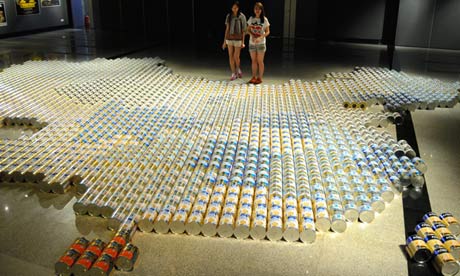Submitted by Berrin Chatzi Chousein
Venice Biennale needs Ai Weiwei – a man who makes art matter
Turkey Architecture News - May 27, 2013 - 19:48 5607 views
Like Beuys in the 70s or Duchamp in 1917, with Ai Weiwei we have the privilege of seeing a modern master in his moment

Land of milk, not honey … Ai Weiwei's map of China, an installation constructed from 2000 baby formula cans. Photograph: The Asahi Shimbun via Getty Images
Who will be the star of this year's Venice Biennale? Ai Weiwei. Not since Joseph Beuys created his sublime installation Tram Stop in the German Pavilion for the 1976 Biennale has Venice foregrounded an artist so much at the peak of his powers.
Ai Weiwei will show work in the very German pavilion whose turbulent history Beuys illluminated, and also has a solo exhibition running as a "collateral" event of the Biennale. Since he matters so much more than any other living artist right now, and operates in his own personal sphere where he can make the slightest things significant – the other day he witnessed and filmed a street fight and it became world news – there is little doubt that he will be the star. He makes art matter, and the Biennale needs an artist who can do that.
Meanwhile, a new installation by Ai Weiwei invites a comparison with the work of Beuys, his German pavilion antecedent.
Ai Weiwei has made a map of China entirely out of cans of formula milk. It comments on another of those running national sores he loves to rub salt into: in 2008, tainted baby milk made 300,000 children ill in China and killed six babies. People no longer trust domestic formula milk and now try to get it from abroad.
It is another piece that uses the language of contemporary art to make a bold intervention in the political arena. From the 1960s to 80s, Beuys was similarly provocative. His acts as a sculptor were part of a larger life as a citizen. His project 7,000 Oaks, unveiled at Documenta in Kassel, involved planting thousands of new oak trees in the city as an ecological gesture of reforestation.
Beuys gave visionary lectures, irritated the authorities and turned ordinary stuff, such as felt, into art.
As with Ai Weiwei, his adventures made his art seem almost a prop for his public persona – but since his death, the power of the art Beuys left behind has become ever greater. His sculpture has immense authority.
But would I rather be in Tate Modern looking around its grandly poetic Beuys room, with the works themselves, revered objects now, free from the man, or would I have liked to witness Beuys in action? With Ai Weiwei we all have the privilege of seeing a modern master in his moment, testing the limits of art and freedom. It's like being the contemporaries of Beuys in the 1970s or Marcel Duchamp when he was calling that urinal art.
This is the moment of Ai Weiwei, an artist who will be the stuff of legend.
by Jonathan Jones
via The Guardian
http://www.guardian.co.uk/artanddesign/jonathanjonesblog/2013/may/21/venice-biennale-ai-weiwei-beuys
